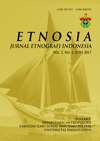Abstract
To become Balinese is to become Hindu with all set of Hinduism and its social norms. This article is focused on the most visible and significant changes in the everyday interaction of Balinese in the transmigration area of Kertoraharjo. As transmigrants, they generally understand that there are 4 categories of Balinese caste (Brahmana, Ksatria, Waisya, and Sudra) and these still exist in Kertoraharjo. However, residential area makes a difference, the practical realities of caste in Kertoraharjo has shown significant changes. Bali coarse language (Bahasa Bali Kasar) has become their daily language, and Bahasa Indonesia is an alternative and casteless language used in every day interaction. For ‘Sudra Kaya’, Balinese names are avoided to eliminate caste identity. The embodiment of caste is reproduced depending the arena and whether the interaction is horizontal or vertical. However, when it comes to rituals, the norms of caste is maintained as this is related to the transedental relations between human being and God, and any violation will result in karma. Any change in the embodiment of caste is legitimated in a phrase: ‘Ini kan bukan Bali’ (‘this is not Bali’).





